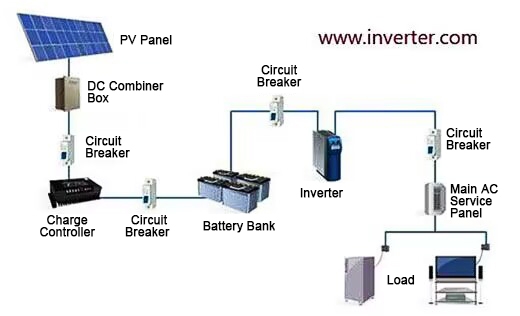The solar charge controller is the brain of the off-grid photovoltaic system. Its function is to protect the battery from charging and discharging. The solar charge controller regulates and controls the power generated by the solar cell module, charges the battery to the maximum extent, and protects the battery from overcharging and over-discharging. In an off-grid solar system, the size selection of the battery and the charge controller is crucial to the performance and stability of the system.
Let us see how we can size the battery bank and solar charge controller.
Battery sizing
We need to calculate how much energy our load needs every day, which can be done by knowing the wattage of each device and how many hours it works every day, multiplying the wattage of each device by its running time, and adding up all the watt-hours of all devices, so that you can get the total energy required for your home every day. Due to losses and inefficiencies, we recommend multiplying the total watt-hours by 1.5 times.
Battery load demand analysis:
Determine the type and power of the load that the off-grid solar system needs to power, including electrical equipment, lighting systems, etc. used in daily life.
Calculate the battery capacity:
Formula: Battery capacity (kWh) = average daily power consumption (kWh/day) x self-sufficiency days/battery discharge depth
For example, the average daily power consumption is 10kWh/day, the self-sufficiency days are 5 days, and the battery discharge depth is 50%, then the battery capacity demand is 10 x 5/0.5 =100kWh.
Battery autonomy days:
We need to indicate the battery's autonomy days, which means the number of days your battery pack can handle your load, usually 3-5 days. The solar battery is based on geographical location and climatic conditions, taking into account the number of days without sunlight, and usually chooses 3-7 days as the number of days of self-sufficiency.
We multiply the total watt-hours per day obtained in the first step above by the number of autonomous days obtained in the second step above, and then multiply by 2 (the number 2 means that the depth of charge in our battery pack system should be 50%, because it does not have to be fully discharged). The result of multiplying these 3 factors is the total watt-hours required for the battery pack. Dividing this value by the battery voltage, we will get the battery pack AH (ampere-hour).
Choose the battery type:
Choose the appropriate battery type according to the system requirements. Such as lead-acid batteries, lithium-ion batteries, etc. Lithium-ion batteries have higher energy density and longer life, but the cost is also higher.
Choose the battery specification:
Choose the appropriate battery specification according to the battery capacity requirements to ensure that it can meet the solar system requirements.
We will indicate how many batteries we will use and how to connect them (parallel and series). In series battery connection, voltages will be added and in parallel connection, currents will be added, so you can configure as you want but remember to achieve the total AH and battery bank voltage calculated in the third step.
Generally, indicating the number of batteries depends on how you will configure it, we mean how many batteries will be in series and how many batteries will be in parallel. Also, remember to use brand new batteries for all batteries because if you use only one old battery then it will degrade and reduce the life of the entire battery system.
Charge Controller Sizing
Solar panel power calculation:
Calculate the power of the required solar panel based on the system's needs and geographical location. Consider factors such as the efficiency and tilt angle of the solar panel.
Determine the maximum charge current:
Determine the maximum charge current based on the output current and voltage of the solar panel. Consider factors such as the efficiency of the solar panel and the efficiency of the system.
Choose a charge controller:
Choose a suitable charge controller based on the maximum charging current. Make sure the rated current of the charge controller is greater than or equal to the maximum charging current.
Consider other functions of the charge controller:
Such as the MPPT (maximum power point tracking) function, which can improve the charging efficiency of the solar panel. Overcharge, over-discharge, short circuit, and other protection functions ensure the safe and stable operation of the system.

